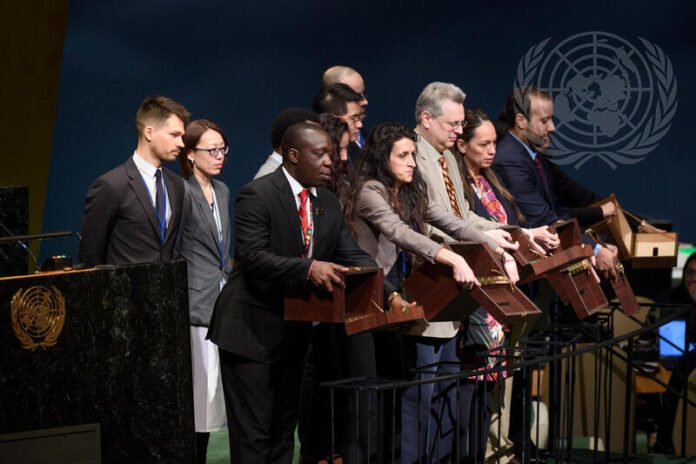Overview of the General Assembly Meeting
The annual General Assembly meeting dedicated to the International Residual Mechanism for Criminal Tribunals (IRMCT) serves as a pivotal platform for discussing the vital role of the IRMCT in international justice. During this meeting, member states convene to review the annual report presented by Graciela Gatti Santana, which encapsulates the Mechanism’s activities and achievements over the preceding year. The IRMCT was established to continue the essential functions of the International Criminal Tribunal for the former Yugoslavia and the International Criminal Tribunal for Rwanda, highlighting its significance in promoting accountability and upholding the rule of law.
This meeting not only aims to evaluate the operational effectiveness of the IRMCT but also addresses emerging challenges that threaten its functionality. A major concern raised during this session is the recent financial liquidity crisis faced by the United Nations. This crisis has had a substantial impact on the IRMCT’s activities, often resulting in delays and limitations in its various proceedings. Such financial constraints can hinder the Mechanism’s ability to execute justice effectively for victims and the broader international community, underscoring the pressing need for robust funding and support.
Key Highlights from the Thirteenth Annual Report
The thirteenth annual report of the International Residual Mechanism for Criminal Tribunals presents significant insights into the agency’s operations and developments from July 2024 to June 2025. A pivotal moment in this period was the conclusion of the mechanism’s fifth review of its mandate, which aimed to assess operational effectiveness and identify areas for enhancement. This review underscored the continued necessity of the mechanism in the broader justice cycle, emphasizing its capacity to deliver accountability for serious international crimes, particularly as transitional justice remains a critical concern in post-conflict scenarios.
In conjunction with the results of the review, Security Council Resolution 2740 (2024) was instrumental in shaping the trajectory of the mechanism’s future activities. This resolution articulated two fundamental messages. First, it reaffirmed the commitment of the United Nations and the international community to uphold accountability for grave violations of international humanitarian law. Second, it stressed the importance of sustained contributions from member states. These contributions are vital for the mechanism’s operations, ensuring that it can function effectively and fulfill its mandate to continue prosecuting outstanding cases.
The implications of Resolution 2740 (2024) on the operational landscape of the mechanism cannot be overstated. In addition to securing continued financial support, the resolution acts as a clarion call for member states to remain engaged in the pursuit of international justice. The reinforced relationship between member states and the mechanism is crucial, as it facilitates collaboration and ensures that justice is not only pursued but achieved. Such collaborative endeavors highlight the ongoing relevance of the mechanism in addressing historical injustices and promoting accountability in conflict-affected regions.
Strategic Planning for Future Functions
The International Residual Mechanism for Criminal Tribunals (IRMCT) has undertaken a comprehensive strategic review to evaluate the transfer of its functions, particularly concerning the supervision of sentence enforcement and the support extended to national jurisdictions. This review process is pivotal, as it must align with the requests put forth by the Security Council, which emphasizes the importance of transitioning certain judicial functions while ensuring effective governance at the national level. The intricacies involved in transferring responsibilities necessitate a delicate balance between local judicial frameworks and the overarching objectives of the international court system.
One of the critical aspects of this strategic review is the ongoing analysis surrounding whether specific judicial roles should remain within the ambit of the IRMCT or be shifted to national jurisdictions. This determination hinges on evaluating the capability of national courts to uphold the principles of justice and fairness that previous international tribunals instilled. The potential transition raises important questions about the equal treatment of defendants and the preservation of the legacies left by prior tribunals. The IRMCT recognizes that transferring these functions carries significant implications for both the credibility of justice delivery and the evolving landscape of international law.
A strategic plan that encompasses these factors is crucial for effectively transitioning roles to national jurisdictions while ensuring that international standards are upheld. This involves a thorough assessment of national judicial capacities, ensuring that they can manage these functions without compromising the legal frameworks established by the former tribunals. By prioritizing equal treatment and recognizing the importance of legacy preservation, the IRMCT can contribute to fostering a more robust international judicial environment while also empowering national courts to play a pivotal role in the administration of justice.
The Legacy of the International Criminal Courts
The establishment of the International Residual Mechanism for Criminal Tribunals (IRMCT) in 2010 marked a significant evolution in the framework of international criminal justice. Established by the United Nations Security Council, the IRMCT serves as a continuation of the functions of the International Criminal Tribunal for Rwanda (ICTR) and the International Criminal Tribunal for the Former Yugoslavia (ICTY). These tribunals were initially instituted to address serious violations of international humanitarian law that occurred during conflicts in Rwanda and the former Yugoslavia, respectively. The creation of the IRMCT was essential for the transition from these ad hoc tribunals to a more lasting legacy of justice.
The IRMCT has inherited and expanded numerous functions from its predecessor tribunals, including the prosecution of remaining fugitives, the management of the archives, and the enforcement of sentences. This continuity is paramount in maintaining accountability in international law, ensuring that the principles of justice are upheld even after the closure of the original tribunals. The Mechanism embodies best practices in the realm of international criminal justice, promoting fairness, transparency, and the protection of victims’ rights. Its role in international jurisprudence has facilitated a more comprehensive understanding of accountability and reconciliation in post-conflict societies.
Nevertheless, the IRMCT faces several challenges that threaten its mission. These include difficulties in tracking down remaining fugitives, ensuring witness protection, and maintaining adequate funding and resources. Furthermore, as a temporary institution, the IRMCT operates with a vision of closure while striving to sustain its legacy. The eventual dissolution of the Mechanism raises critical questions regarding its judicial accomplishments and the lasting impact of its work on the international legal landscape. Reflecting on its establishment, the IRMCT not only adheres to the principles derived from the ICTR and ICTY but also aspires to create an enduring legacy that reinforces the role of justice in the global context.

